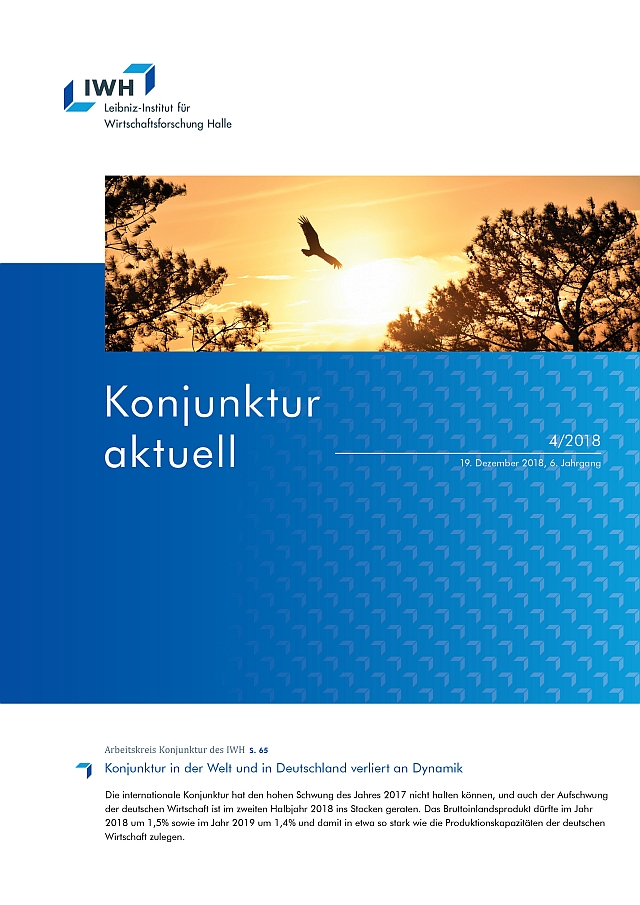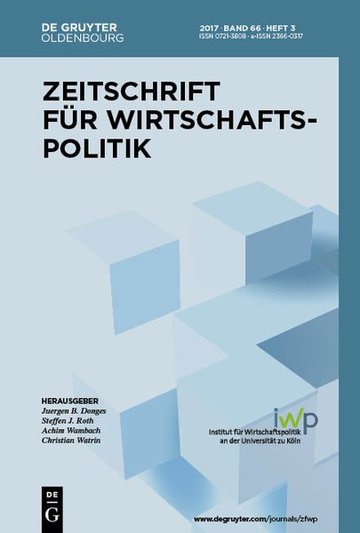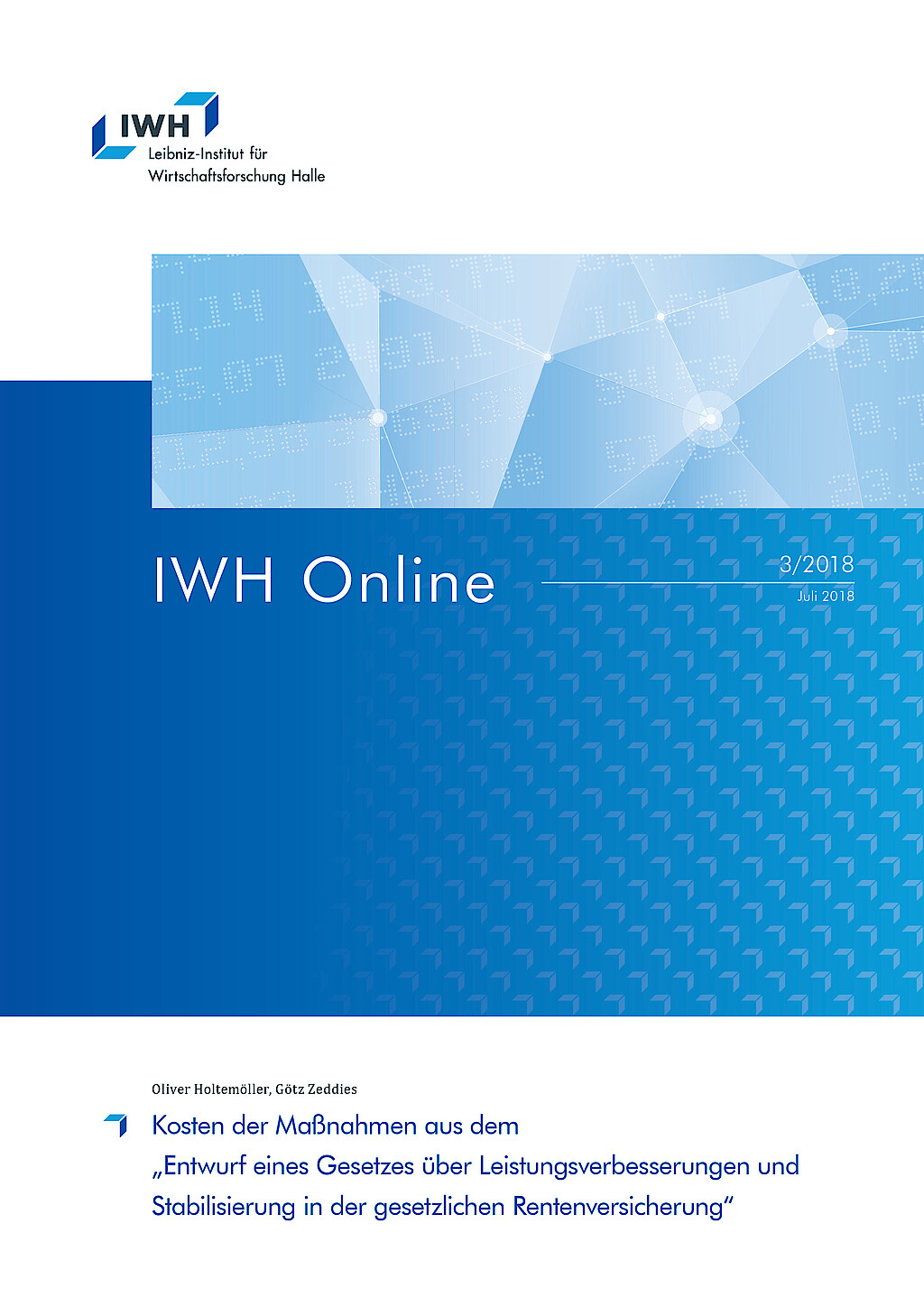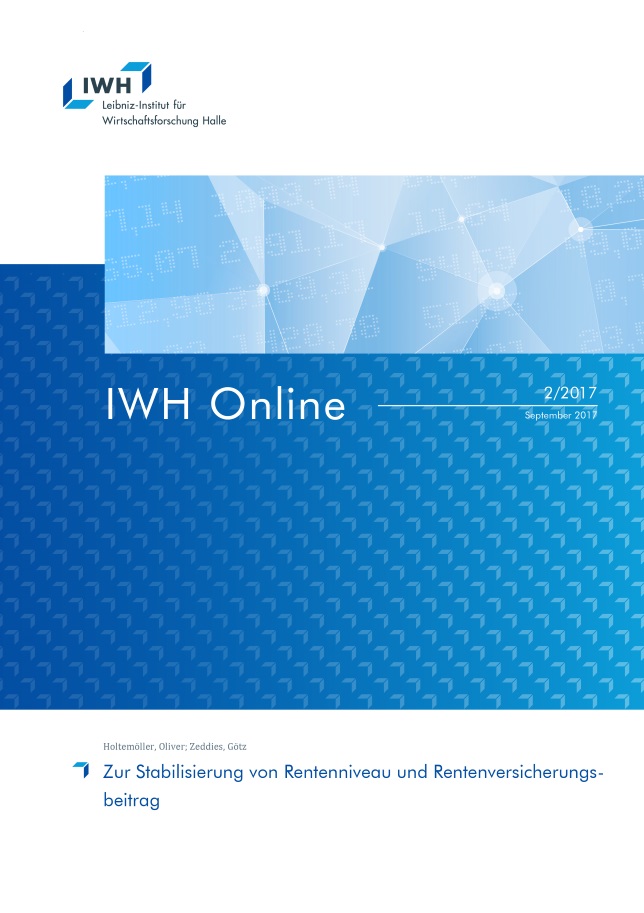
In a nutshell
Many thousands of refugees flocked to EU member states in 2015 and 2016, especially to Germany. As has been widely and controversially discussed. The much more serious and longer-term problem of demographic change has been adeptly sidestepped, however. Although it may sound unpopular to some: immigration is vital for Germany, as there is no other way to offset demographic change. This is because the population is constantly ageing and neither the labour market, municipal infrastructure investments, nor the German pension system are currently adequately prepared.
Our Expert

President
If you have any further questions please contact me.
+49 345 7753-700 Request per E-MailAll experts, press releases, publications and events on "Demographic Change"
Europe's century-long task
The increasingly ageing population is already high on the political agenda and will pose a major challenge for the next generation. If things remain as they are, today's children will have to pay much higher pension contributions than their parents and grandparents – and receive considerably less money in return when they are old. Although demographic change is considered when adjusting pensions, this is not sufficient to prevent the scenario just described. There are certainly alternatives, however, to the existing system. For instance, pension levels at retirement age could be fixed at current levels, or even slightly higher, and the pensions of those who have already retired only be increased in line with inflation. Living standards would therefore be maintained. On the other hand, people's work-life balance must be improved, so that couples are not afraid to have children. Almost 10 years ago, the IWH determined that women only continue to work part time after having children, particularly in western Germany.
Germany's towns are also paying too little attention to demographic change and thus the future. They primarily make investments based on the current financial situation and too little on how the population will develop in future. If towns continue to do this, some will be chronically under-funded and others over-funded in 20 years' time.
Another problem is the shortage of skilled workers. In order to make it attractive for well-trained specialists to move to Germany from overseas, a targeted immigration policy is required. The projects launched to date, such as Blue Card, have not been as successful as hoped. So Germany currently remains isolated from the international pool of highly-qualified workers. A points-based system could be a promising alternative.
At the same time, Germany is facing the huge humanitarian dilemma of refugees; the enormous wave of migration since 2015 is placing considerable demands on Europe. The asylum system in Europe still has major shortcomings. A coherent European asylum policy is currently more important than ever, but the refugees have been very unevenly distributed within Europe. The IWH mooted a strategy for their equitable distribution back in 2015, which takes into account both the allocation of people and the costs.
In addition, the state must sustainably manage the integration of newcomers into our culture and labour market. This also includes improving social mobility within our society, in order to provide immigrants with good training opportunities. "Germany has been asleep for the last ten years. We have not seriously considered how we will handle our population development in 15 years' time," says Reint Gropp, President of the IWH in an interview with Mitteldeutsche Zeitung.
Despite the intake of 1.2m refugees over the past two years, Germany’s population suffers a serious decline. Especially in Eastern Germany total population shrinks. According to the OECD, about half of asylum-seekers who started off in eastern Germany in the past moved to places such as Hamburg once they secured their permit.
Whether and how this country can make economic use of the opportunities presented by immigration is currently still under discussion. Integration is a fundamental part of this debate. Due to the complexity of the issue, an interdisciplinary, scientific approach, such as that of the ‘Crises of a globalised world’ Research Group, is essential, in order to understand the reciprocal mechanisms and dynamics. For example, analyses by the IWH show that measures to cope with immigration during late 2015 triggered additional economic impetus. National and regional governments increased their budgets, while spending on housing, food, medical care and general support for refugees fuelled demand and production, especially in the construction and hospitality sectors, as well as in professional services. According to calculations by the Joint Economic Forecast Project Group, migration-related expenditure across Germany contributed 0.1 percent to the growth in gross domestic product in 2015.
Today, one in 113 people in the world is considered to be a refugee – 65 million in total. In order to resolve the complex ‘asylum’ problem, politicians need to be much better organised and ideally develop collective actions. This is the only way to achieve a solution that is as efficient as possible – and above all humanitarian.
Demographic change is profoundly affecting various social spheres, yet is still underestimated by politicians and citizens. Pensions, future investments, migration – all these things are having a direct, immediate impact on people in Germany. Which is precisely why timely, sustainable solutions are required that do not simply pay lip service to sustainability.
Publications on "Demographic Change"

Mittelfristprojektion des IWH: Wirtschaftsentwicklung und Öffentliche Finanzen 2018 bis 2025
in: Konjunktur aktuell, No. 4, 2018
Abstract
In Deutschland wird die Anzahl der Erwerbspersonen mittelfristig aufgrund der Alterung der Bevölkerung sinken und damit auch das Wirtschaftswachstum niedriger ausfallen als in den vergangenen Jahren. Gleichzeitig hat die Bundesregierung eine Reihe von zusätzlichen Staatsausgaben beschlossen. Auf der Grundlage einer gesamtwirtschaftlichen Projektion mit dem IWH-Deutschlandmodell lässt sich aber zeigen, dass es bis zum Jahr 2025 kaum zu Haushaltsdefiziten kommt, auch wenn sämtliche im Koalitionsvertrag enthaltenen finanzpolitischen Maßnahmen umgesetzt werden. Selbst wenn sich die makroökonomischen Rahmenbedingungen verschlechtern, etwa wegen eines deutlichen Zinsanstiegs oder eines Einbruchs der ausländischen Nachfrage, würde der Finanzierungssaldo zwar negativ, die zu erwartenden Defizite lägen aber dennoch wohl unter 0,5% in Relation zum Bruttoinlandspro-dukt. Ein Einbruch der ausländischen Nachfrage würde die Produktion zwar stärker dämpfen als ein Zinsschock, die Effekte auf den gesamtstaatlichen Finanzierungssaldo wären aber vergleichbar. Denn ein Zinsschock belastet eher die Binnennachfrage, von deren Rückgang die staatlichen Einnahmen stärker betroffen sind als von einem Rückgang der Exporte. Für die kommenden Jahre dürfte der deutsche Staatshaushalt damit recht robust sein; dabei ist aber zu beachten, dass etwa die aus dem Rentenpaket resultierenden Mehrausgaben erst nach dem Jahr 2025 deutlich zu Buche schlagen.

Zu den rentenpolitischen Plänen im Koalitionsvertrag 2018 von CDU, CSU und SPD: Konsequenzen, Finanzierungsoptionen und Reformbedarf
in: Zeitschrift für Wirtschaftspolitik, No. 3, 2018
Abstract
In the coalition agreement from February 7, 2018, the new German federal government drafts its public pension policy, which has to be evaluated against the background of demographic dynamics in Germany. In this paper, the consequences of public pensions related policy measures for the German public pension insurance are illustrated using a simulation model. In the long run, the intended extensions of benefits would lead to an increase in the contribution rate to the German public pension insurance of about two and a half percentage points. Referring to pension systems of other countries, we discuss measures in order to limit this increase in the contribution rate.

Kosten der Maßnahmen aus dem „Entwurf eines Gesetzes über Leistungsverbesserungen und Stabilisierung in der gesetzlichen Rentenversicherung“
in: IWH Online, No. 3, 2018
Abstract
Der Referentenentwurf des Gesetzes über Leistungsverbesserungen und Stabilisierung in der gesetzlichen Rentenversicherung sieht folgende Leistungsausweitungen in der gesetzlichen Rentenversicherung vor: Fixierung des Rentenniveaus bei 48% und der Haltelinie für den Beitragssatz bei 20%, Aufstockung der Mütterrente, Verbesserungen für Erwerbsgeminderte und Ausweitung der Gleitzone (so genannte „Midijobs“). Diese Maßnahmen werden vor allem langfristig erhebliche Auswirkungen auf die Ausgaben der Rentenversicherung haben; gleichzeitig wird die Anzahl der Beitragszahler aufgrund der Alterung der Bevölkerung abnehmen. Das heißt, selbst ohne die neuen Leistungsausweitungen stiegen die Abgaben (Beiträge und Steuern) zur Finanzierung der Rentenversicherung langfristig deutlich an. Berechnungen mit dem Rentensimulationsmodell des IWH zeigen, dass die effektive Abgabenlast (Rentenversicherungsbeitrag plus Steuerzuschüsse) in Relation zum Lohn bis zum Jahr 2050 ohne die neuen Leistungsausweitungen um acht und mit um weitere drei Prozentpunkte zunehmen dürfte. Wenn der Beitragssatz bei 20% konstant gehalten werden soll, müssten etwa die Einkommensteuer oder die Umsatzsteuer entsprechend kräftig erhöht werden.

Zur Stabilisierung von Rentenniveau und Rentenversicherungsbeitrag
in: IWH Online, No. 2, 2017
Abstract
Ursprünglich galt die Sicherung des Lebensstandards nach dem Ausscheiden aus dem Erwerbsleben als zentrale Aufgabe der gesetzlichen Rentenversicherung. In der öffentlichen Diskussion gilt deshalb der Entwicklung des Rentenniveaus, welches das Verhältnis der Standardrente zum durchschnittlichen Arbeitsentgelt wiedergibt, besondere Aufmerksamkeit. Ein kontinuierlich sinkendes Rentenniveau wird häufig als nicht hinnehmbar angesehen, weil dadurch soziale Härten entstehen können. Aufgrund des demographischen Wandels, der sich in den kommenden Jahren beschleunigen wird, ginge eine Fixierung des Rentenniveaus jedoch mit einem deutlichen Anstieg des Beitragssatzes zur gesetzlichen Rentenversicherung und damit der Lohnnebenkosten einher. Mit dem Altersvermögens- und dem Altersvermögensergänzungsgesetz wurde deshalb ab dem Jahr 2001 ein Paradigmenwechsel in der gesetzlichen Rentenversicherung vollzogen. So wurde unter anderem ein Nachhaltigkeitsfaktor in die Rentenanpassungsformel aufgenommen, welcher die Rentenanpassung bei einer Alterung der Bevölkerung dämpft. Für das Rentenniveau wurde lediglich eine Untergrenze von 43% im Jahr 2030 festgelegt; der Beitragssatz soll bis dahin die Obergrenze von 22% nicht übersteigen.

Predicting the Rise of EU Right-Wing Populism in Response to Unbalanced Immigration
in: Complexity, August 2017
Abstract
Among the central tenets of globalization is the free migration of labor. Although much has been written about the benefits of globalization, little is known about its limitations and how antiglobalist sentiment can be strongly affected by high levels of immigration. Analyzing poll data from a group of EU countries affected by the recent migrant crisis, we find that over the last three years the percentage of right-wing (RW) populist voters in a given country depends on the prevalence of immigrants in this country’s population and the total immigration inflow into the entire EU. The latter is likely due to the perception that the EU functions as a supranational state in which a lack of inner borders means that “someone else’s problem” can easily become “my problem.” We find that the increase in the percentage of RW voters substantially surpasses the percentage of immigration inflow, implying that if this process continues, ongoing democratic processes will cause RW populism to prevail and globalization to rapidly decrease. We locate tipping points between the fraction of immigrants and the rise of RW populism, and we model our empirical findings using a complex network framework in which the success of globalization rests on a balance between immigration and immigrant integration.



